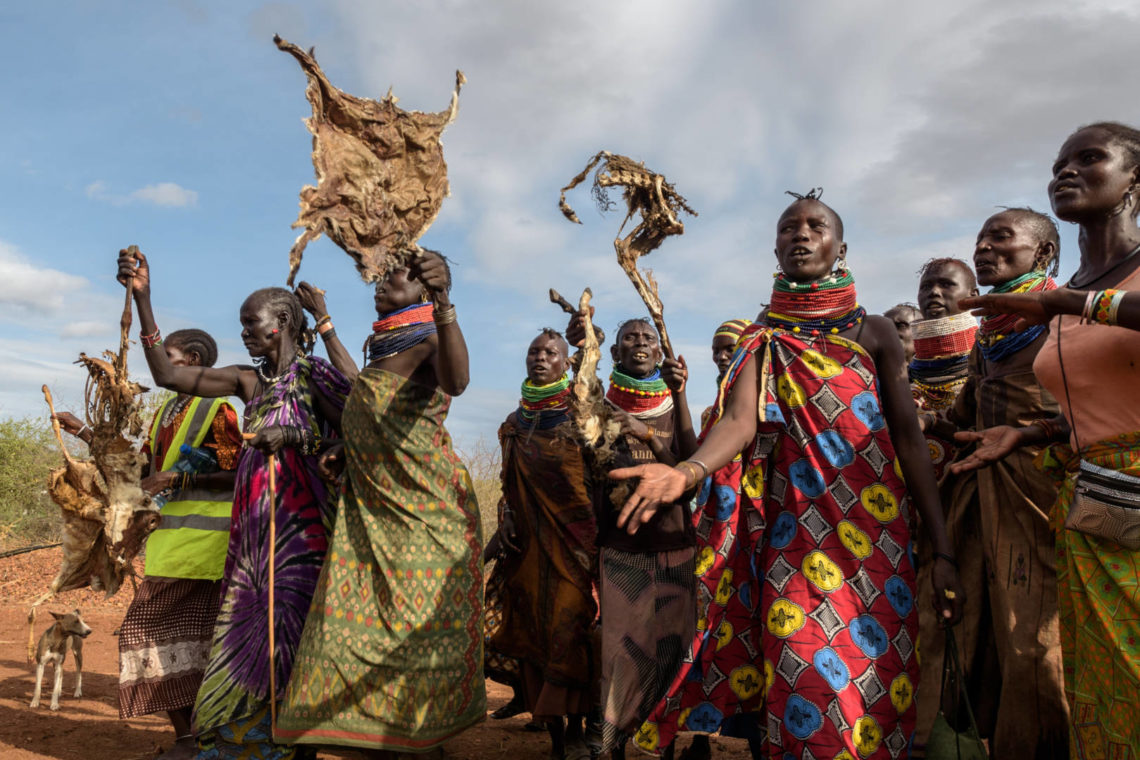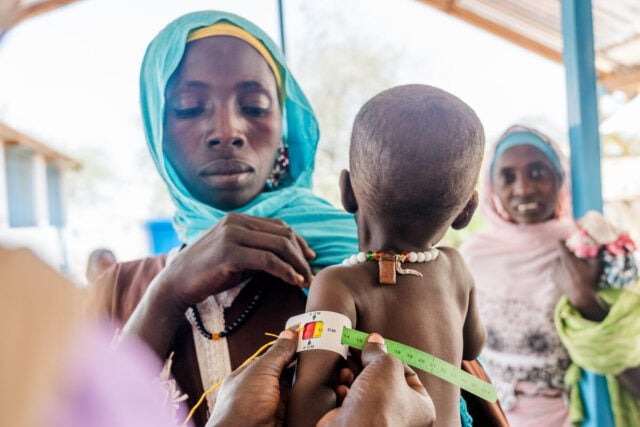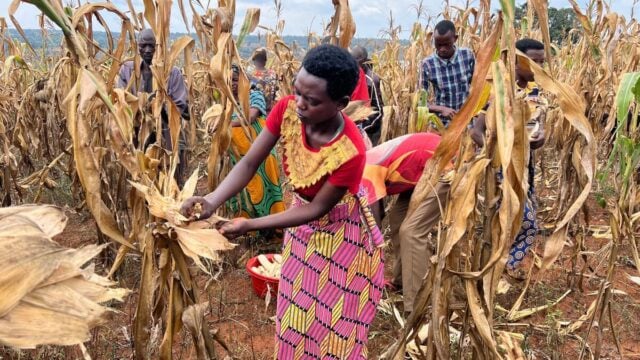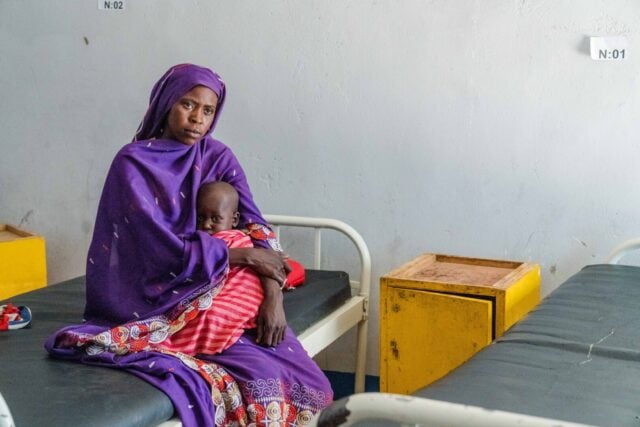East Africa faces a monster food crisis. If the world stands by, “people will simply starve to death,” says Stephen O’Brien, United Nations Under-Secretary-General for Humanitarian Affairs. But in four countries where World Vision works, relief and development are forming an effective alliance in the war against hunger.
In East Africa, Peter and Samson hunt for squirrels and stones — squirrels to eat, and stones to mark their mother’s fresh grave. The boys are orphans. Their mother died of hunger in April, and their father was shot to death in a cattle raid near South Sudan.
“The drought has finished all the animals,” says Samson, 10. “Now it is killing people.” As they hunt, the boys collect stones to place gently on their mother’s grave as a sign of remembrance. “It makes it sacred,” says Peter.
In northern Kenya, 9-year-old Ejiem mourns his favorite sheep, Merireng, now rotting in the noonday sun. “He was beautiful,” he says. “When I found Merireng dead, I started crying. Of all the animals, he was the one I loved the most.” Merireng was more than a friend. He was one of 100 sheep and goats that nourished the family and served as income for trade. The drought killed them all. “When the goats die, we go hungry,” says Ejiem. “When they die, we have nothing.”
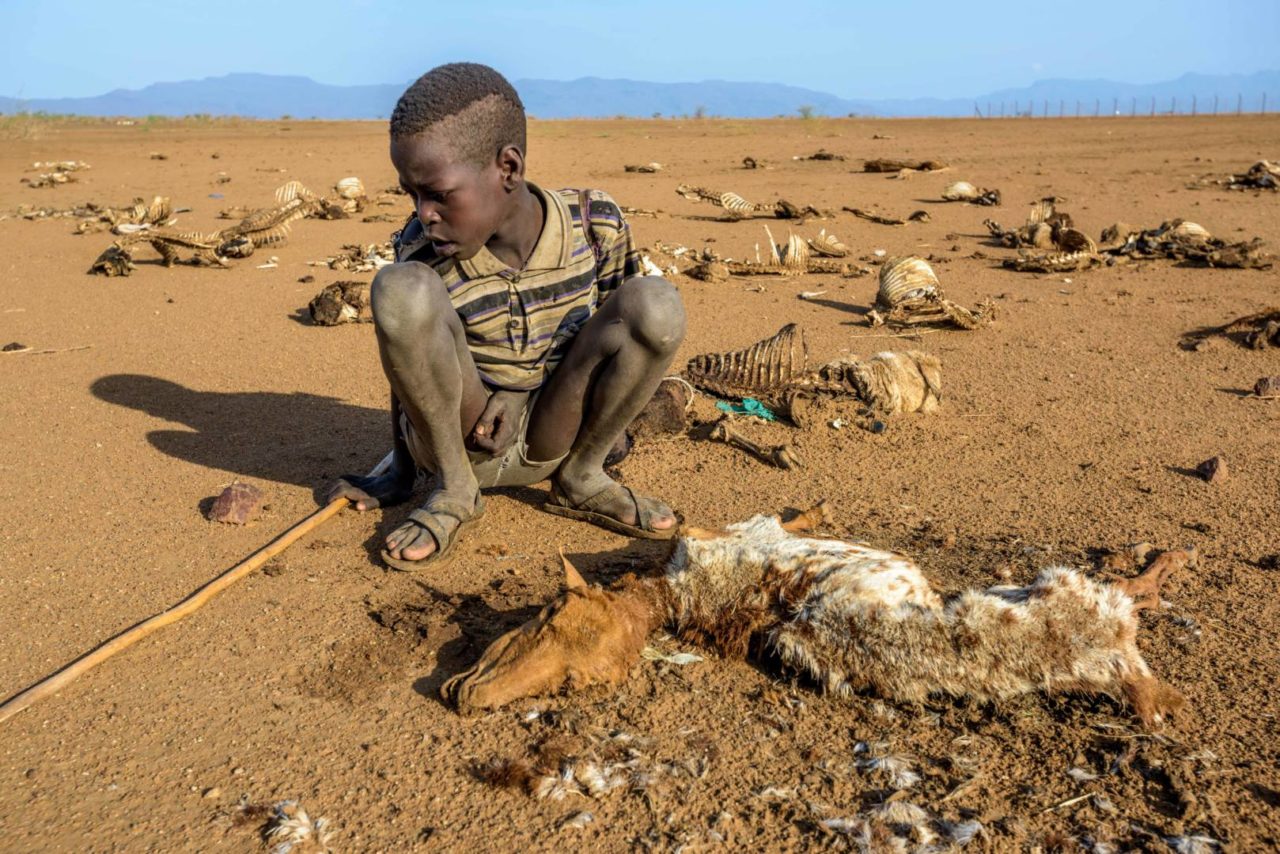
In Somalia, Suray misses her children. She took all seven of them on a two-week trek to Baidoa in a desperate search for food, but one by one they weakened and died, the last one a baby she was breastfeeding. Kind villagers helped her dig a shallow grave in the hard ground. “I was not in my senses anymore,” she says. “I was lost in my grief. I don’t even know how I got here.”
Thousands of other families across East Africa are at risk of living similar stories. An estimated 25 million people in East Africa need humanitarian assistance. They teeter on the brink of disaster in what U.N. officials warn could become the worst humanitarian crisis since World War II. Without immediate intervention, they risk death by starvation.
The food crisis and its causes
“This disaster is massive,” says Chris Hoffman, who directs World Vision’s humanitarian and emergency affairs in East Africa from Nairobi. “The size and the scope of what we are dealing with now is exponentially more” than the 2011 famine in the Horn of Africa, he says. “This is the worst hunger crisis in a generation. Starvation is lurking on the doorsteps of hundreds of thousands of children.
This crisis has no single cause, but climate is a big contributor. Ethiopia, where 1 million people died in the 1984 famine, is the country hit hardest by El Niño-caused weather disruption. When rains failed last year, Ethiopia plunged into hunger. Now, armyworms — fat grass-eating caterpillars that travel in packs — ravage crops in the south.
In Somalia and Kenya, poor rains have left families without food, water, or animals, resulting in intense fighting as people scramble for remaining resources.
Right now we have 850,000 malnourished children in East Africa. Without immediate action, between 30% and 50% of these children will die.”—Chris Hoffman, director of World Vision’s humanitarian and emergency affairs in East Africa
Conflict is the other major contributor to the hunger crisis. South Sudan and Somalia rank first and second on the Fragile States Index, which tracks countries with weakened governments. Countries at war often top the list. Fragile states are less resistant to shocks like conflict. South Sudan has not suffered drought, but
South Sudan has not suffered drought, but ongoing civil war has displaced 3.6 million of the country’s 12 million people. “Conflict is driving these people out of their homes, not allowing them to plant the food they need,” says Chris. Today, 7.5 million people in South Sudan are in need of humanitarian assistance.
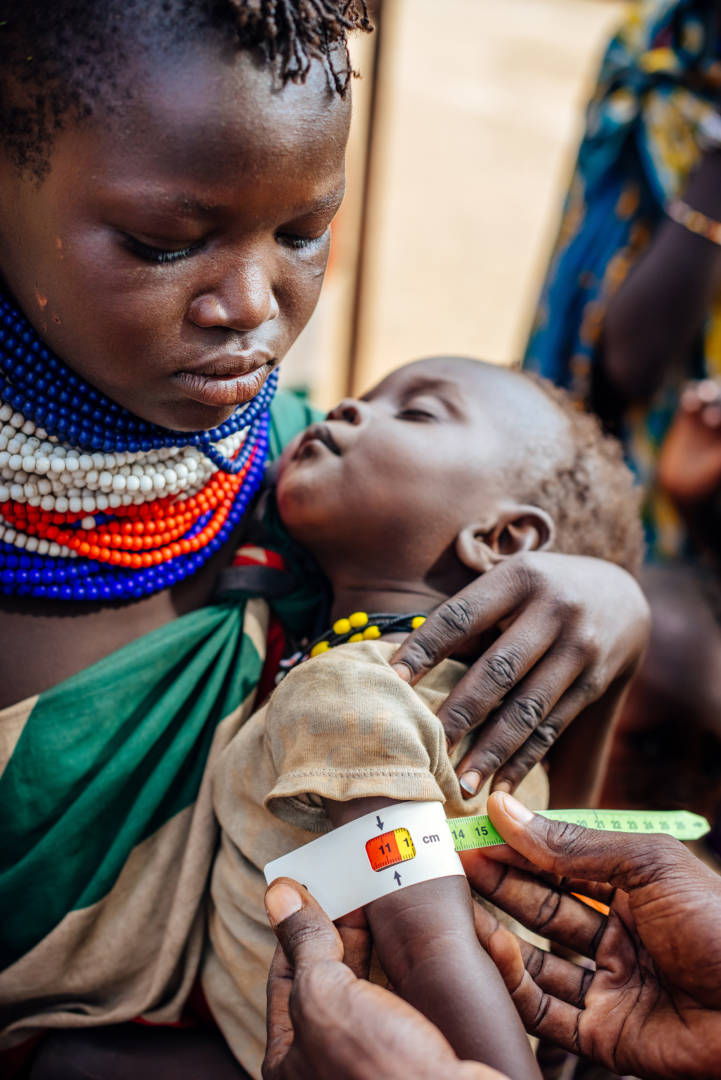
Only one thing about this crisis comes as a surprise — its sheer magnitude. World Vision and other nongovernmental organizations rely on tools such as the Famine Early Warning System (FEWS) developed by USAID after the 1984 Ethiopia famine, to predict and respond to hunger crises. FEWS monitors changes in climate and uses satellite imagery to monitor crop production.
“We all use [FEWS],” says Chris. “We live by it. But FEWS doesn’t take into account either access or conflict.” Violence keeps people on the run, unable to grow and harvest crops. And it can limit the ability of humanitarian groups like World Vision to reach people who need relief supplies.
“Right now we have 850,000 malnourished children in East Africa,” he says. “Without immediate action, between 30% and 50% of these children will die.” During the 2011 hunger crisis in Somalia, most of the deaths happened between May and July.
“We haven’t yet seen the ugly head of the animal in the cave,” says Chris. “If we don’t throw a missile into that cave, he is going to come out and wreak his wrath in the next three months.”
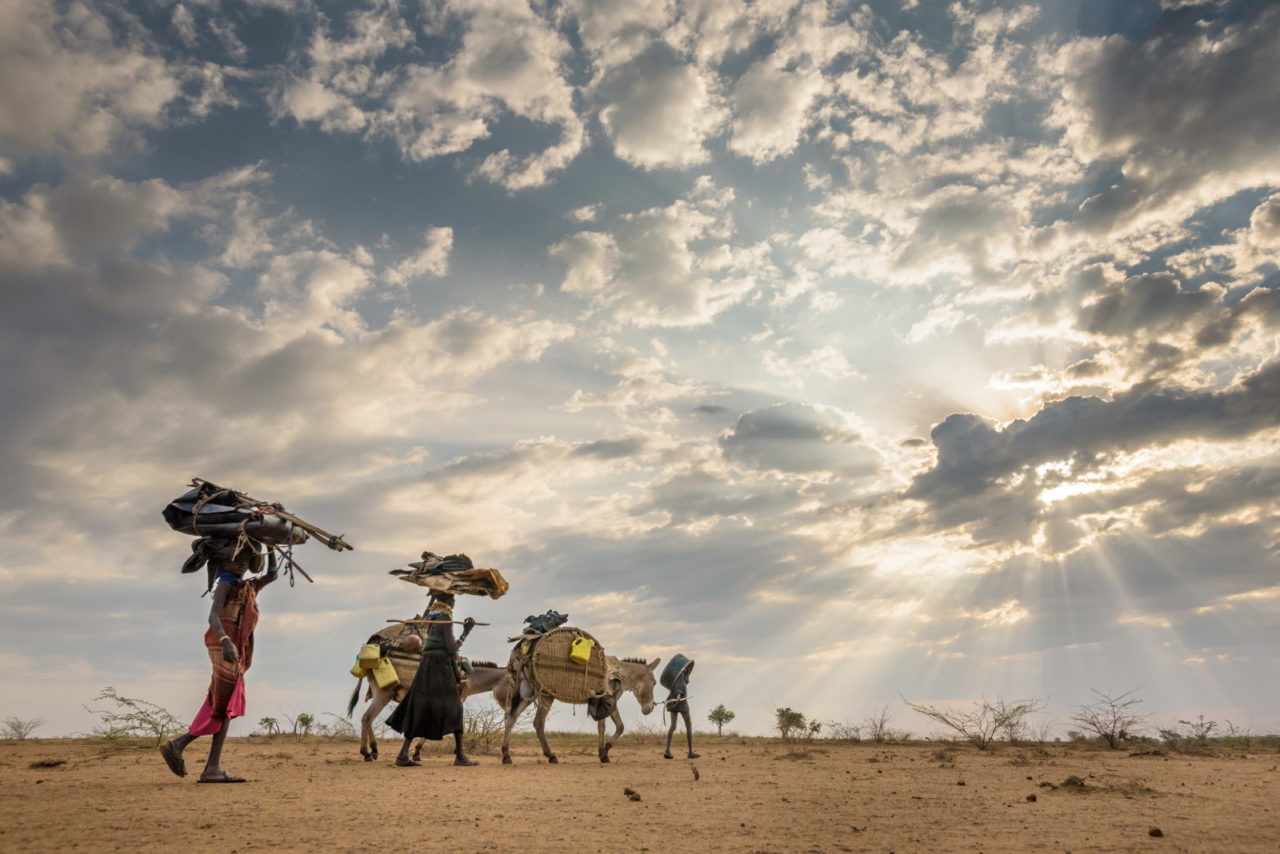
Spotlight: Hunger in Turkana, Kenya
The “ugly animal” is already wreaking its wrath in Turkana, an area in northwest Kenya. Here, drought has decimated flocks, created conflict, displaced families, and left children and their parents weak and despondent.
People are taking desperate action — raiding livestock or risking a dangerous journey to find food and water.
“People are living in fear,” says Michael Losiru, the assistant chief of Nanaam, a community near the border with South Sudan. He is exhausted after failing to foil a livestock raid in which five people were killed and 275 animals taken. Nanaam means “water,” but there is little to be found.
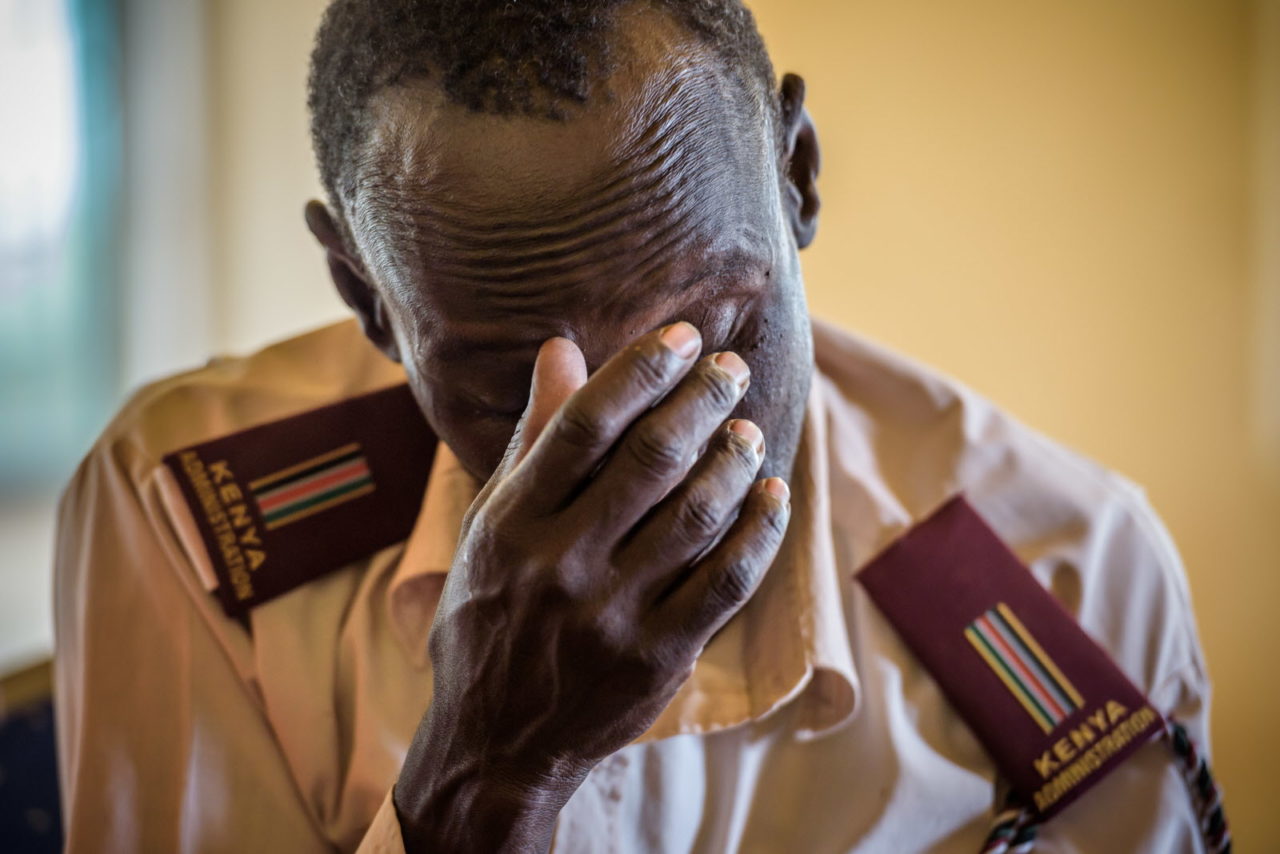
“The land would be beautiful,” Michael says, if not for the drought. “There would be grass, animals, but now …” He trails off, massaging his forehead.
Families are on the move. Lopenyon Marwa and her grandchildren have been on the road for four long days, migrating 50 miles to Nanaam, hoping to find food for themselves and their last two donkeys. Lopenyon had skinned a donkey that had recently died. She carried the skin rolled up on her head, using it to shelter the children from the hot sun and to sleep on at night. “This is the most terrible drought,” she says. “All my children are scattered.”
Villagers renamed Nanaam, calling it Ngikwasinyen — “dry sand” — after a series of droughts. “There was a river here that used to flow with water,” says Nalet Ekapuon, 53, a father of six. Nalet and his friend Tukur Ekapuon, 47, are former pastoralists who now hunt for animals to eat. “It’s not good,” says Tukur, “but I have to get something to eat.”
The people of Turkana are pastoralists, or herdsmen, who depend on seasonal rains that provide food for their animals. The animals, which serve as their food and their livelihoods, are nearly gone. Joseph Adome, who directs World Vision’s work in Turkana, says rainfall was measly last fall — just 100 milliliters, or 3.38 ounces. (Imagine a travel-size liquid container.) Grasslands have turned into graveyards as the carcasses of donkeys, cattle, sheep, and goats litter the landscape, their ribcages white mounds jutting from the brown dirt.
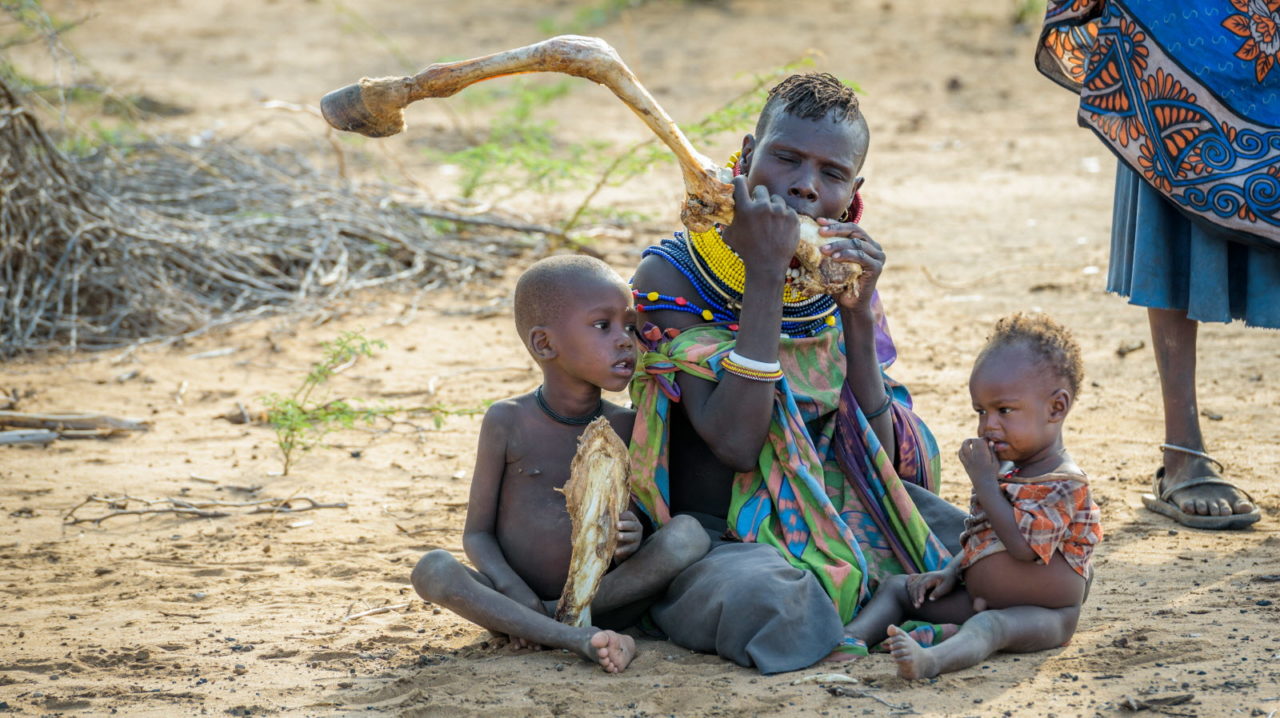
Tukur shoots hyenas and vultures that prey on the bodies of dead livestock. The women roast hyena on a spit and dry the stomachs so they’ll last. The people of Turkana have never eaten these foods before, and the children hate it. “Hyena is bitter,” says Naroo, 9. “When we eat it, it gives us diarrhea. But it’s the only food on the table.” Naroo’s mother can no longer breastfeed the baby. “She wants to be fed all the time,” she says. “When we see our children so hungry, we feel like committing suicide.”
Other mothers have expressed similar sentiments while watching their children waste away. The Global Acute Malnutrition rate, which indicates the severity of a hunger crisis, is 30% in Turkana. “In 100 children, 30 of them are wasted,” explains Lydia Ndungu, a nutritionist with World Vision. “When a child is wasted, they have lost muscle and fat mass.” Visible signs are a change in hair color and skin luster.
Upon returning home from a failed mission to find vultures or hyena, Nalet is bone-tired. “We have no water, food, or medicines,” he says. “If you don’t take care of these children, they will die.”
World Vision’s response to East Africa’s agony
World Vision has declared the East Africa hunger crisis as the most severe category of emergency, focusing relief operations in Ethiopia, South Sudan, Somalia, and Kenya:
Ethiopia
- 7.7 million people need humanitarian assistance
- 303,000 expected to be severely malnourished this year
- Conditions: Drought, food insecurity, disease, armyworm infestations
- World Vision Interventions: Health and nutrition, water and sanitation, education and protection, food security and livelihoods
- 707,350 have received aid from World Vision
South Sudan
- 7.5 million people need humanitarian assistance
- 3.6 million displaced (1.7 million left the country as refugees)
- 840,000 children under 5 acutely malnourished, 270,000 severely malnourished
- Conditions: Conflict, food insecurity, lack of humanitarian access, inflated food prices, disease
- World Vision Interventions: Food security and livelihoods, water and sanitation, health and nutrition, education and protection
- 469,400 have received aid from World Vision
Somalia
- 6.7 million people need humanitarian assistance
- 1.1 million displaced
- 363,000 children under 5 acutely malnourished, 71,000 severely malnourished
- Conditions: Drought, conflict, food insecurity, malnutrition, disease (cholera, measles, diarrhea outbreaks), displacement
- World Vision Interventions: Health and nutrition, food security and livelihoods, water and sanitation, education
- 335,000 have received aid from World Vision
Kenya
- 2.7 million need humanitarian assistance, including 700,000 children under 5
- 500,000 refugees have left the country
- 500,000 children under 5 acutely malnourished
- Conditions: Drought, food insecurity, malnutrition, disease, displacement, armyworm infestations, conflict overe resources
- World Vision Interventions: Health and nutrition, water and sanitation, food security and livelihoods, education and child protection
- 236,000 have received aid from World Vision
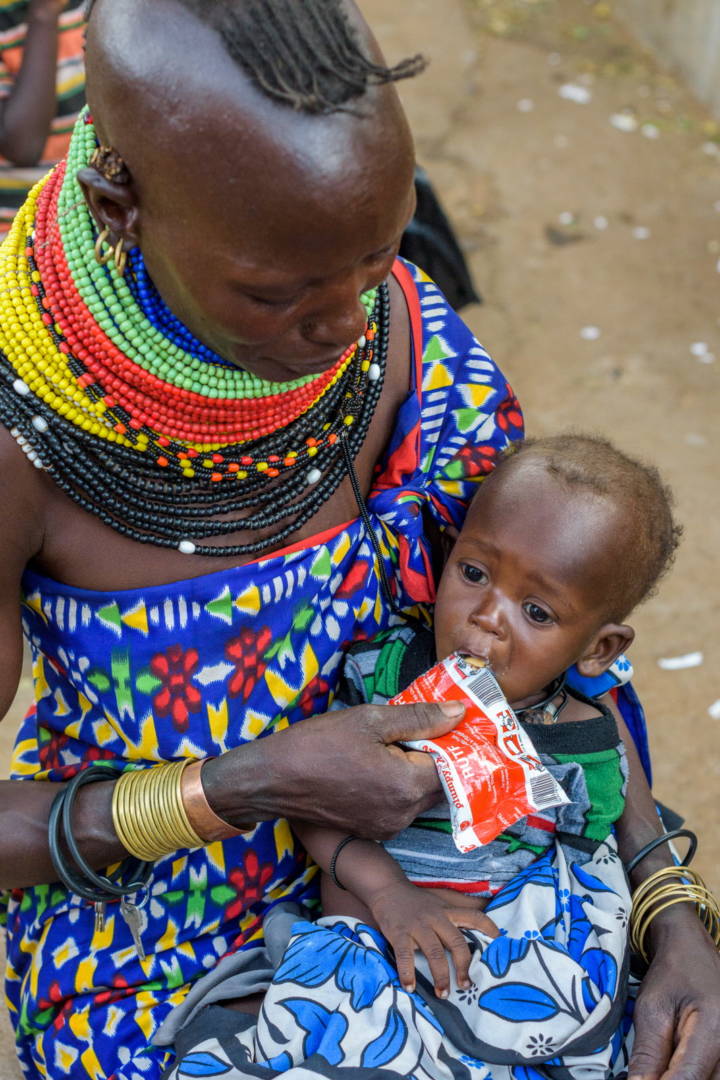
Nakwam, who is severely malnourished. (©2017 World Vision/photo by Jon Warren)
So far, World Vision has reached 1 million people with humanitarian assistance in East Africa and is working to help 2.7 million more.
Food distributions are critical to fighting hunger’s advancement. “We are the largest partner with the World Food Programme globally,” says Chris. “No one reaches more people with food than we do. When people need food, World Vision is there.”
A second distinctive: water. “We reach one new person with water every 10 seconds,” says Chris. “People can live without food, but they can’t live without water. That’s the reality.”
World Vision moves fast. “We were the first organization on the ground in northern Uganda when [South Sudanese refugees] started to come over the border at [a rate of] 2,000 a day,” says Chris. “That was 800,000 refugees ago. We are still there, and we are still responsive.”
Immediate assistance also comes through life-saving work in nutrition and health. In Turkana, World Vision nutritionist June Cherutich, 25, spends three weeks of every month monitoring health facilities to ensure they are stocked with the tools needed to save lives, such as ready-to-use therapeutic food for young children suffering from acute malnutrition.
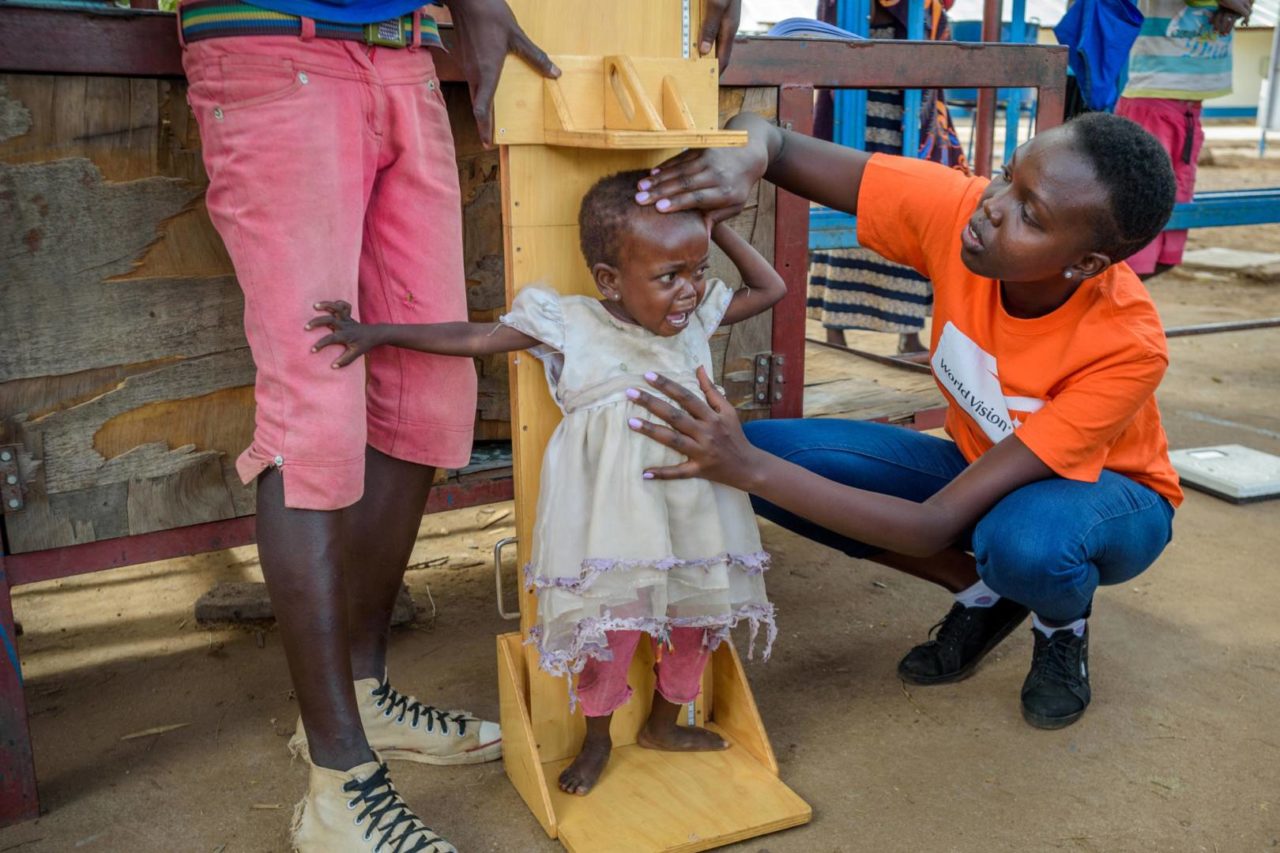
Baby Akusi received some of this emergency food. “When the drought started,” says her mother, “it started with a wind. I named her after the wind.” Akusi’s father was killed in a cattle raid, leaving her mother to raise five children on her own.
Nutritionists measure Akusi’s mid-upper arm circumference, weigh her, and measure her height to calculate her z-score. A healthy child should have a z-score of 0, but Akusi has a z-score of -3. Her mother is given packets of ready-to-use therapeutic food and instructed to return the next week for weighing and measuring.
June predicts that early intervention will save the baby’s life. “She would have died of dehydration or diarrhea,” she says. “Akusi would have just slept into death.” The next day, Akusi’s mother will also receive a 55-pound bag of corn-soy blend, fortified with vitamins A and D, to enable her to continue to breastfeed.
World Vision also conducts a cash transfer program. The most vulnerable people in communities like Ngikwasinyen receive 3,700 Kenyan shillings a month (US$37) to buy what they need to survive. The amount goes far in Turkana’s economy.
Ethiopia: Bringing water during a drought
For years, Ethiopian farmers and herders have faced recurring drought that has worn down their land, livestock, and ability to make a living. Spring and summer rainfall has declined steadily since the mid-1970s, and the El Nino effect in 2015 and 2016 made things worse.
This year, 9.1 million Ethiopians will need water and sanitation assistance. “Women and girls travel up to 20 km (12.7 miles) to fetch water or buy a jerry can of water,” says Aysha Haji Jundi, a 37-year-old mother in Goro district. “Children are forced to drop education due to lack of food and searching for water.”
Where World Vision has sponsorship programs, support for water, sanitation, and hygiene helps “weatherproof” the lives of children. We build and rehabilitate wells, extend pipelines, and teach hygiene practices. Bringing water and sanitation to schools and health centers puts education and life-saving medical care within reach of whole communities.
Running hungry: South Sudanese refugees in Uganda
A brutal civil war that began in December 2013 has driven 1.7 million South Sudanese to flee their country. Across the border in Uganda, there will soon be 900,000 of them. About 86% of refugees are women and children, many of them desperately hungry, malnourished, and anemic.
The famine and hunger crisis in South Sudan is not about drought, says World Vision’s Chris Hoffman. It’s conflict. And because of the conflict, World Vision and other aid groups cannot reach people in some of the worst-affected parts of South Sudan.
World Vision hands out high-energy biscuits and bottled water — enough to tide refugees over for a day — at a Uganda reception center. When they move on to a refugee camp, World Vision is there to serve a hot meal and to provide food aid furnished by the World Food Programme.
Other World Vision services for South Sudanese refugees: Child-Friendly Spaces, education, water and sanitation, and household goods.
Somalia: Young lives marred by hunger, disease
As cattle have died and crops have withered, parents have no other option but to take their children and flee to urban areas and camps for displaced people. More than 500,000 Somalis are displaced, many living in crowded and unsanitary conditions. Childhood malnutrition has reached staggering numbers: At least 363,000 Somali children under age 5 are acutely malnourished; 71,000 are severely malnourished.
But hunger is not the only killer stalking the children. Communicable diseases like measles take a toll on their weakened bodies. Since seasonal rains began, so have massive outbreaks of cholera and acute watery diarrhea, with double the cases of recent years.
Nunay Awiyow sits by the bedside of her three children who are being treated for diarrhea in a hospital in Baidoa. “My children are getting the help and care they need. I am hopeful they will get well,” she says. Nunay grieves her 5-year-old daughter who died before they reached the hospital.
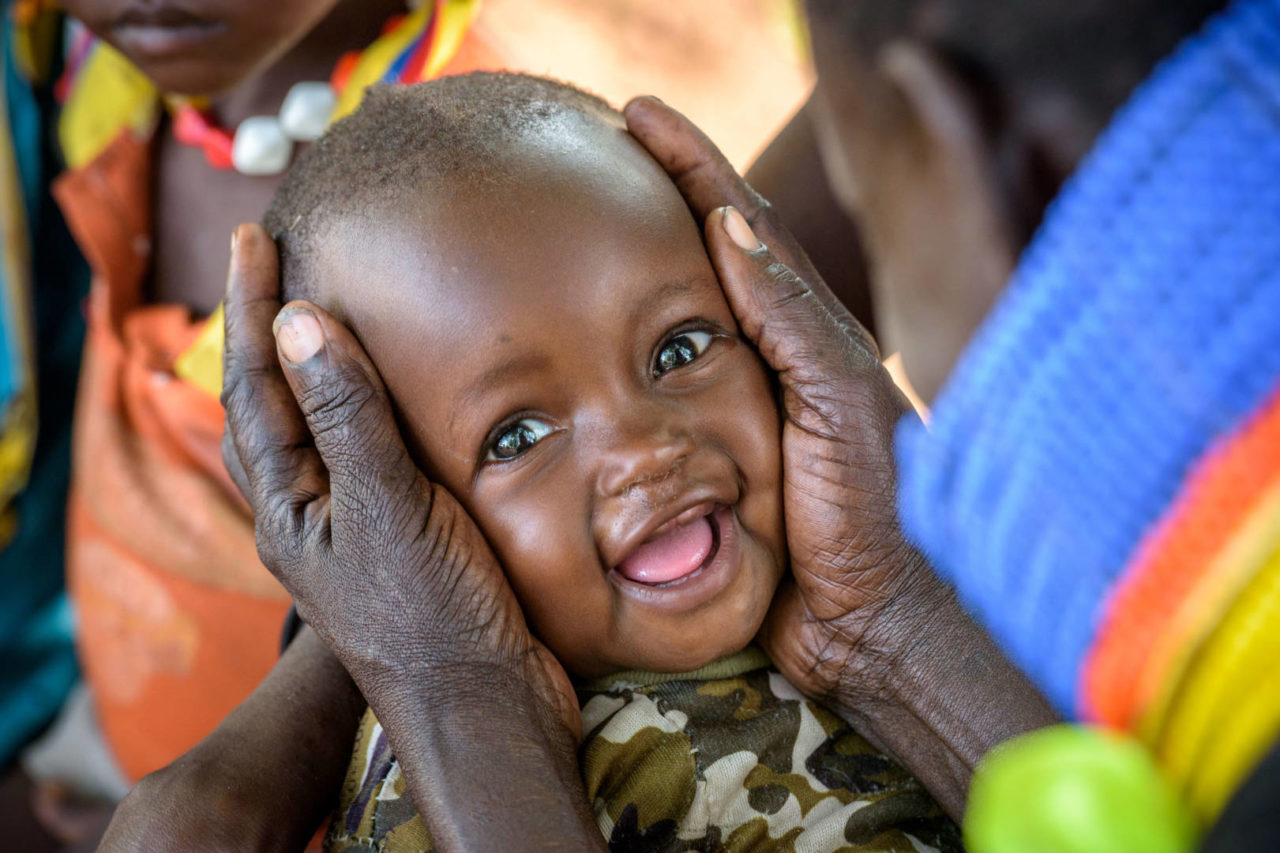
Planting seeds of hope
Child sponsorship is a powerful tool that outfits communities to battle hunger. “The kind of programming that we do through sponsorship prepares communities to respond to disaster,” says Gershon Mwakazi, sponsorship manager for World Vision Kenya.
South Sudan and Somalia don’t have sponsorship projects yet because of instability in those countries — but in Kenya, where World Vision has worked since 1974, 33,000 children have sponsors in the U.S. In Ethiopia, 48,300 children have American sponsors.
Child sponsorship funds become lifesaving funds when a disaster strikes. “We can use 20% of our sponsorship funding to reprogram and address the drought,” says Gershon. “Where we have program areas affected by drought, we are trucking water to schools. We are also giving water purification tablets to people who are getting water from bad sources.”
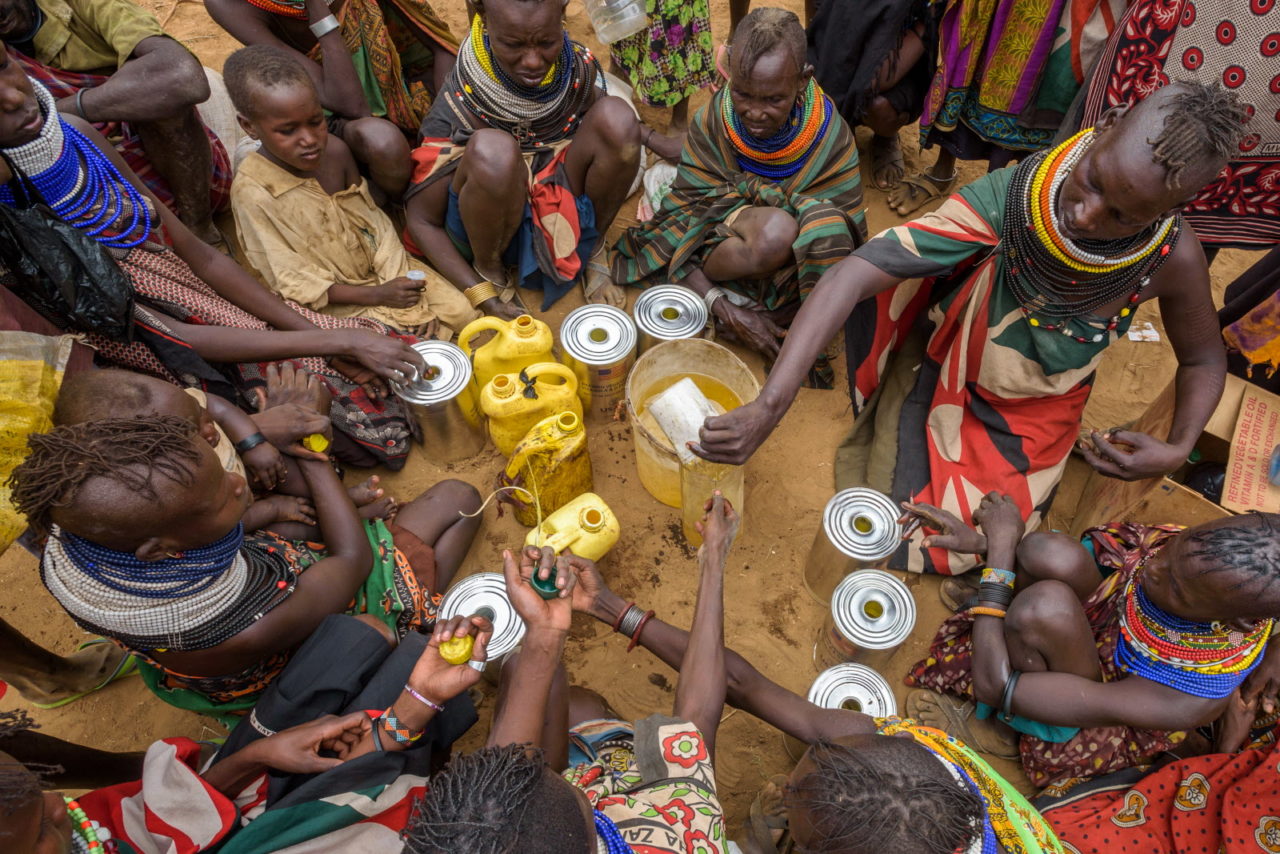
Since World Vision spends more than a decade with families in sponsorship communities, it’s possible to go deeper — not just helping people through a crisis, but equipping them to resist the next one. Staff use an approach called “empowered worldview” to change mindsets, helping people understand their value as beings created in God’s image. This biblically based approach teaches communities that they have the capacity to transform themselves — they don’t have to be dependent on outsiders.
June Cherutich, the nutritionist, was trained in this approach. “My takeaway was how I would be able to build up communities and change their mindset,” says June. “It’s not about what we are giving, but what they have. It’s a total shift.”
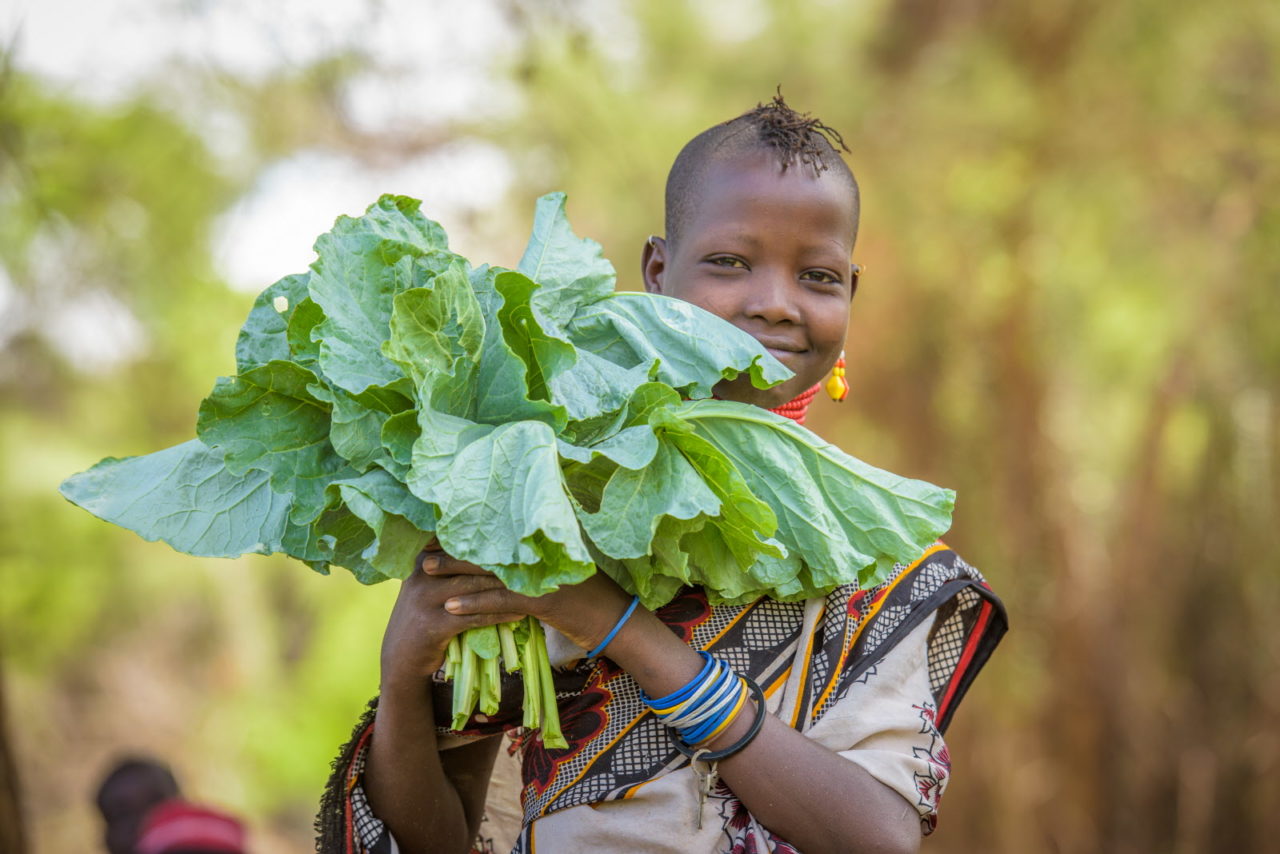
One example is World Vision’s Food for Assets program in Turkana. Staff taught more than 6,000 people in 42 communities to create zai pits — shallow holes in the ground that can capture rainfall when it comes. Farmers learned to plant maize seeds in these pits, rather than just scattering seeds.
As the community prepares the land for planting, they receive food from World Vision every month — maize, beans, and vegetable oil. Community members run the distributions. There is even a “help desk” to settle any squabbles and to make sure that everything runs smoothly.
The villagers own the project. “The community used to call this ‘World Vision work,’” says field monitor Fred Mzee. “Now they are saying, ‘This is our work.’ They are creating their own assets.”
The time is now
Thabani Maphosa, a World Vision expert on food security and livelihoods, recently told a U.S. congressional Foreign Affairs subcommittee, “We are seeing the window of opportunity to avert a larger catastrophe rapidly closing.”
Over the next months, World Vision and others are responding to avert the rising hunger crisis, raising funds for millions of East Africans caught on the battlefield of hunger. The window is closing. We must act now.
How you can help stop the East Africa food crisis
- Join us in prayer for people who are hungry around the world and those working to feed them.
- Sponsor a child in Africa.
- Provide immediate relief: Donate today and see your gift multiply seven times in impact to save lives in East Africa — including South Sudan, Somalia, Ethiopia, and Kenya.
Kathryn Reid of World Vision’s staff in the U.S. contributed to this story.
